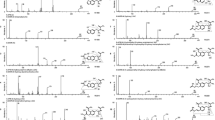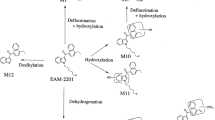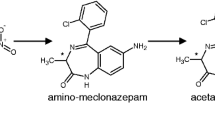Abstract
Purpose
Norflurazepam, also a metabolite of other prescription benzodiazepines, appeared on the new psychoactive substances (NPS) drug market recently, complicating the interpretation of NPS findings. The aims of the study were to tentatively identify potential metabolites of norflurazepam and structural analogues (flurazepam, fludiazepam and cinolazepam) produced by hepatocytes and in authentic human samples and to discuss the possibility to differentiate drug consumption.
Methods
Each drug (5 µmol/L) was incubated with pooled human hepatocytes, and metabolites were identified using liquid chromatography–high-resolution mass spectrometry (LC–HRMS). Similarly, urine with/without hydrolysis and blood/serum from three flurazepam and seven presumptive norflurazepam cases were analysed by LC–HRMS.
Results
No metabolites were detected for norflurazepam in hepatocytes, but six metabolites for flurazepam, two for fludiazepam and three for cinolazepam were found. In human specimens collected after flurazepam ingestion, a total of eight metabolites, in good agreement with hepatocyte metabolites, were detected. In specimens of presumptive norflurazepam intake, norflurazepam and its metabolites (four hydroxy metabolites and one glucuronide of a hydroxy metabolite) were found.
Conclusions
Based on the results, hydroxy metabolites for norflurazepam, N-(hydroxyethyl), desethyl and didesethyl for flurazepam, hydroxy for fludiazepam and glucuronides and N-(hydroxyethyl) for cinolazepam are recommended for monitoring. While flurazepam, fludiazepam and cinolazepam were metabolised by hepatocytes at side chain, norflurazepam was not, which seems to indicate that hepatocytes have difficulty in modifying the benzene/diazepine rings of some 1,4-benzodiazepines. As for confirming the intake of norflurazepam, the urine ratio of 3-hydroxy-norflurazepam/norflurazepam might be the key; a high ratio might be correlated to norflurazepam intake, thereby enabling the differentiation.






Similar content being viewed by others
References
Manchester KR, Lomas EC, Waters L, Dempsey FC, Maskell PD (2018) The emergence of new psychoactive substance (nps) benzodiazepines: a review. Drug Test Anal 10:37–53. https://doi.org/10.1002/dta.2211
European Monitoring Centre for Drugs and Drug Addiction (2018) European drug report 2018: trends and developments. https://doi.org/10.2810/800331
Moosmann B, King LA, Auwärter V (2015) Designer benzodiazepines: a new challenge. World Psychiatry 14:248. https://doi.org/10.1002/wps.20236
Moosmann B, Bisel P, Westphal F, Wilde M, Kempf J, Angerer V, Auwärter V (2009) Characterization and in vitro phase i microsomal metabolism of designer benzodiazepines—an update comprising flunitrazolam, norflurazepam and 4′-chlorodiazepam (ro5-4864). Drug Test Anal. https://doi.org/10.1002/dta.2561
de Silva JAF, Strojny N (1971) Determination of flurazepam and its major biotransformation products in blood and urine by spectrophotofluorometry and spectrophotometry. J Pharm Sci 60:1303–1314. https://doi.org/10.1002/jps.2600600903
Greenblatt DJ, Shader RI, Koch-Weser J (1975) Flurazepam hydrochloride. Clin Pharmacol Ther 17:1–14. https://doi.org/10.1002/cpt19751711
Schwartz MA, Postma E (1970) Metabolism of flurazepam, a benzodiazepine, in man and dog. J Pharm Sci 59:1800–1806. https://doi.org/10.1002/jps.2600591220
Hasegawa M, Matsubara I (1975) Metabolic fates of flurazepam. I. Gas chromatographic determination of flurazepam and its metabolites in human urine and blood using electron capture detector. Chem Pharm Bull 23:1826–1833. https://doi.org/10.1248/cpb.23.1826
Kaplan SA, De Silva JAF, Jack ML, Alexander K, Strojny N, Weinfeld RE, Puglisi CV, Weissman L (1973) Blood level profile in man following chronic oral administration of flurazepam hydrochloride. J Pharm Sci 62:1932–1935. https://doi.org/10.1002/jps.2600621205
Breimer D, Jochemsen R (1983) Clinical pharmacokinetics of hypnotic benzodiazepines: a summary. Br J Clin Pharmacol 16:277S–278S. https://doi.org/10.1111/j.1365-2125.1983.tb02300.x
Fujiwara S, Takagi A, Awata N (1986) In vitro and in vivo metabolism of flutoprazepam and fludiazepam in mice (in japanese with english abstract). Drug Metab Pharmacokinet 1:77–86. https://doi.org/10.2133/dmpk.1.77
Sonka K, Sós P, Susta M (2014) Past and present in drug treatment of sleep disorders. Neuro Endocrinol Lett 35:186–197
Smyth WF, McClean S, Ramachandran VN (2000) A study of the electrospray ionisation of pharmacologically significant 1,4-benzodiazepines and their subsequent fragmentation using an ion-trap mass spectrometer. Rapid Commun Mass Spectrom 14:2061–2069. https://doi.org/10.1002/1097-0231(20001115)14:21%3c2061:AID-RCM135%3e3.0.CO;2-8
Smyth WF, Joyce C, Ramachandran VN, O’Kane E, Coulter D (2004) Characterisation of selected hypnotic drugs and their metabolites using electrospray ionisation with ion trap mass spectrometry and with quadrupole time-of-flight mass spectrometry and their determination by liquid chromatography-electrospray ionisation–ion trap mass spectrometry. Anal Chim Acta 506:203–214. https://doi.org/10.1016/j.aca.2003.11.034
Risoli A, Cheng JBY, Verkerk UH, Zhao J, Ragno G, Hopkinson AC, Siu KWM (2007) Gas-phase fragmentation of protonated benzodiazepines. Rapid Commun Mass Spectrom 21:2273–2281. https://doi.org/10.1002/rcm.3084
Smyth TJP, Robledo VR, Smyth WF (2010) Characterisation of oxazepam degradation products by high-performance liquid chromatography/electrospray ionisation mass spectrometry and electrospray ionisation quadrupole time-of-flight tandem mass spectrometry. Rapid Commun Mass Spectrom 24:651–658. https://doi.org/10.1002/rcm.4433
Laurito TL, Mendes GD, Santagada V, Caliendo G, de Moraes MEA, De Nucci G (2004) Bromazepam determination in human plasma by high-performance liquid chromatography coupled to tandem mass spectrometry: a highly sensitive and specific tool for bioequivalence studies. J Mass Spectrom 39:168–176. https://doi.org/10.1002/jms.590
Moosmann B, Bisel P, Auwärter V (2014) Characterization of the designer benzodiazepine diclazepam and preliminary data on its metabolism and pharmacokinetics. Drug Test Anal 6:757–763. https://doi.org/10.1002/dta.1628
Schwartz MA, Koechlin BA, Postma E, Palmer S, Krol G (1965) Metabolism of diazepam in rat, dog, and man. J Pharmacol Exp Ther 149:423–435
Seddon T, Michelle I, Chenery RJ (1989) Comparative drug metabolism of diazepam in hepatocytes isolated from man, rat, monkey and dog. Biochem Pharmacol 38:1657–1665. https://doi.org/10.1016/0006-2952(89)90314-6
Vikingsson S, Wohlfarth A, Andersson M, Gréen H, Roman M, Josefsson M, Kugelberg FC, Kronstrand R (2017) Identifying metabolites of meclonazepam by high-resolution mass spectrometry using human liver microsomes, hepatocytes, a mouse model, and authentic urine samples. AAPS J 19:736–742. https://doi.org/10.1208/s12248-016-0040-x
Wohlfarth A, Vikingsson S, Roman M, Andersson M, Kugelberg FC, Green H, Kronstrand R (2017) Looking at flubromazolam metabolism from four different angles: metabolite profiling in human liver microsomes, human hepatocytes, mice and authentic human urine samples with liquid chromatography high-resolution mass spectrometry. Forensic Sci Int 274:55–63. https://doi.org/10.1016/j.forsciint.2016.10.021
Fujisaki H, Hirotsu K, Ogawa T, Mizuki K, Mizuta H, Arima N (2001) Metabolism of quazepam and its metabolites in humans: identification of metabolic enzymes and evaluation of drug interaction in vitro (in japanese with english abstract and figures). Drug Metab Pharmacokinet 16:558–568. https://doi.org/10.2133/dmpk.16.558
Valdes J, Boggs DL, Boggs AA, Rey JA (2016) Clinically significant interactions with benzodiazepines. In: Jann MW, Penzak SR, Cohen LJ (eds) Applied clinical pharmacokinetics and pharmacodynamics of psychopharmacological agents. Springer, Cham, pp 471–495. https://doi.org/10.1007/978-3-319-27883-4
Sidelmann UG, Cornett C, Tjørnelund J, Hansen SH (1996) A comparative study of precision cut liver slices, hepatocytes, and liver microsomes from the Wistar rat using metronidazole as a model substance. Xenobiotica 26:709–722. https://doi.org/10.3109/00498259609046744
Brandon EFA, Raap CD, Meijerman I, Beijnen JH, Schellens JHM (2003) An update on in vitro test methods in human hepatic drug biotransformation research: pros and cons. Toxicol Appl Pharmacol 189:233–246. https://doi.org/10.1016/S0041-008X(03)00128-5
Greenblatt DJ (1981) Clinical pharmacokinetics of oxazepam and lorazepam. Clin Pharmacokinet 6:89–105. https://doi.org/10.2165/00003088-198106020-00001
Acknowledgements
This work was supported by the Vinnova (the EUROSTARS Psychomics project, Grant Number 10628) and Strategic Research Area in Forensic Sciences (Strategiområdet forensiska vetenskaper, grant number 2016:7) at Linköping University.
Author information
Authors and Affiliations
Corresponding author
Ethics declarations
Conflict of interest
The authors declare that they have no conflict of interest.
Ethical approval
All procedures performed in studies involving human participants were in accordance with the ethical standards of the regional ethics committee in Linköping (Approval Number 2018-186/31) and with the 1964 Helsinki declaration and its later amendments or comparable ethical standards.
Additional information
Publisher's Note
Springer Nature remains neutral with regard to jurisdictional claims in published maps and institutional affiliations.
Electronic supplementary material
Below is the link to the electronic supplementary material.
Rights and permissions
About this article
Cite this article
Watanabe, S., Vikingsson, S., Åstrand, A. et al. Metabolism of the benzodiazepines norflurazepam, flurazepam, fludiazepam and cinolazepam by human hepatocytes using high-resolution mass spectrometry and distinguishing their intake in authentic urine samples. Forensic Toxicol 38, 79–94 (2020). https://doi.org/10.1007/s11419-019-00488-9
Received:
Accepted:
Published:
Issue Date:
DOI: https://doi.org/10.1007/s11419-019-00488-9




